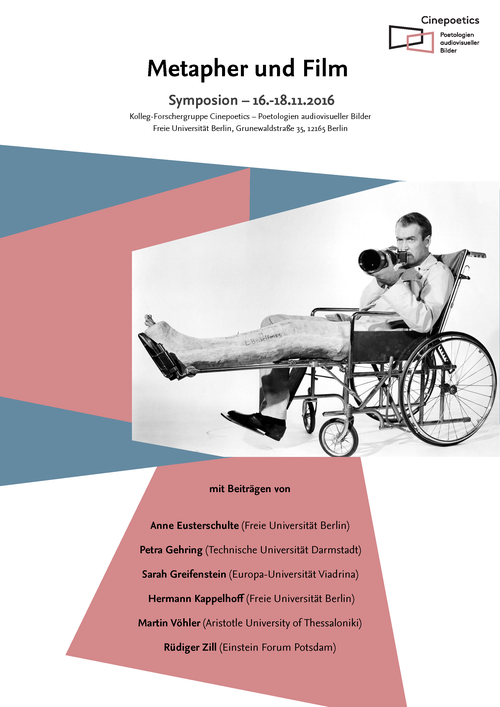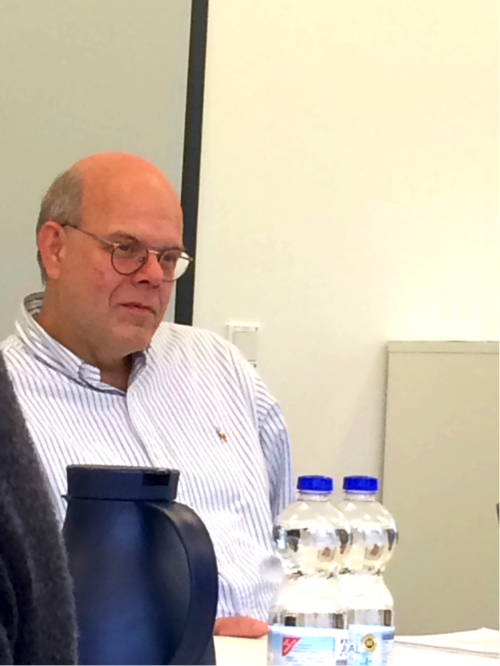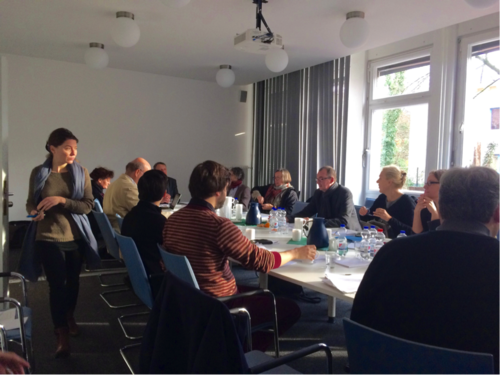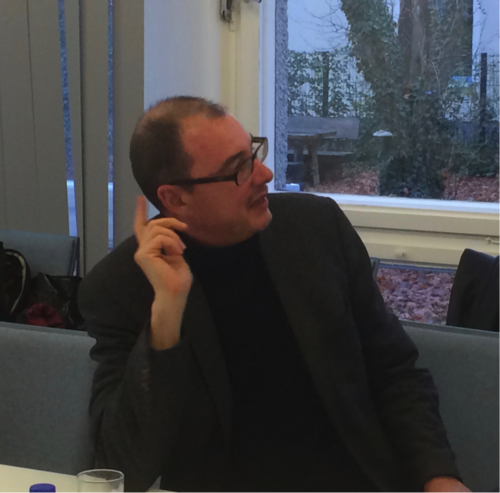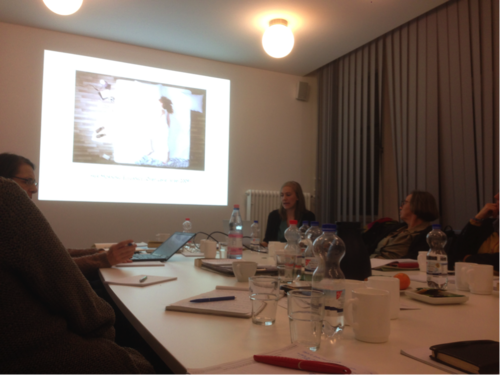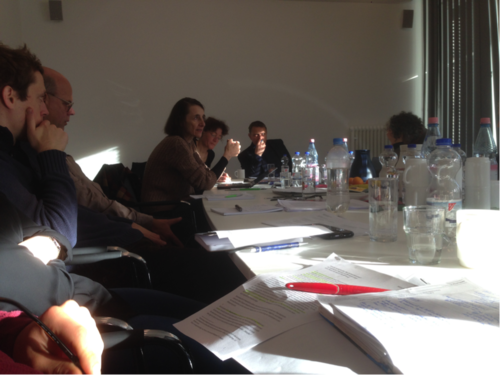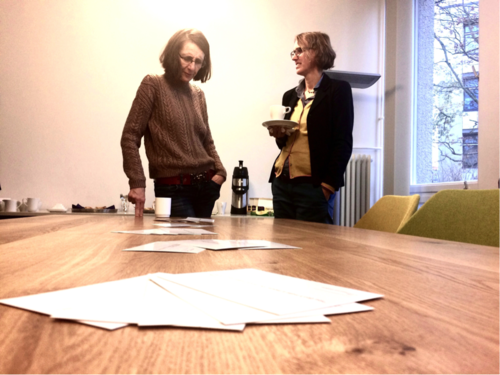Metaphor and Film
16. - 18.11.2016 | Symposium by the Cinepoetics group with Petra Gehring, Martin Vöhler and Rüdiger Zill.
Nov 13, 2016
In order to look back at last year's research focus and trace out possible paths for further research on cinematic metaphors, the first Cinepoetics symposium focused on the relationship between metaphor and film through the lens of Hans Blumenberg's writings. The three-day event featured presentations by Martin Vöhler (Aristotle University Thessaloniki), Rüdiger Zill (Einstein Forum Potsdam), Hermann Kappelhoff (Freie Universität Berlin), Sarah Greifenstein (Europa Universität Viadrina, Frankfurt/Oder), Petra Gehring (Technische Universität Darmstadt), and Anne Eusterschulte (Freie Universität Berlin).
The symposium began with a Wednesday afternoon screening of Alfred Hitchcock's Rear Window and continued on Thursday with Martin Vöhler's elaborations on Blumenberg’s conception of reality and his related thoughts on the potential of novels. In this perspective, the artistic medium of the novel is an indicator of modern art insofar as it designates a transition from, and a break with the tradition of, the Greek epos and its implied principles of the cosmos.
Furthermore, for Blumenberg, the truth claim of literature and poetry is based on three logical options: a reference to a given reality, the creation of a particular idiosyncratic reality, and a total indifference of an artistic construct towards truth or lie. Here, as Vöhler explained, the notion of evidence has to be specified as a momentary recognition and acknowledgment of reality, which is tightly connected to the metaphorical connotations of light. In this regard, the idea of metaphor is close to the functionality of myths, as myths can be conceived of as actualizations of questions for which we technically cannot find definitive answers.
Rüdiger Zill continued this close reading of Blumenberg's work in his presentation. For him, visibility, the status of the image, and the conception of absolute metaphors are closely linked in Blumenberg's work. Zill pointed out how metaphors always act as a replacement for images (in the Kantian sense), as they are analogies of relations rather than actual linguistic terms. Thus, Blumenberg's project of metaphorology is not a categorization of metaphors at all; rather, it is to be understood as a warning system or an ignition point of debate. As Zill put it, metaphorology is a history of histories or a story of stories (the German term "Geschichte" has two meanings).
In an effort to connect Blumenberg's notions to the work of Cinepoetics, Zill named the forming of conciseness and narrativity as possible linkages. According to him, one has to note three levels of cinematic metaphors: metaphoricity in the image, film image as a metaphor, and filmic features as part of a larger form of expression. Also, Zill underlined the importance of the central feature of metaphors: seeing something as something different at the same time, which becomes very literal in the realm of film.
In their joint presentation, Hermann Kappelhoff and Sarah Greifenstein investigated how interactions between audiovisual images can generate the representations we consider fundamental for constructions of meaning. As they pointed out, audiovisual art forms always have to face the problem of communicating aesthetic experiences. Seen in this light, metaphorical concepts are to be understood as communicators, as networks of interrelating metonymic and metaphorical transfers. However, it is only by means of reconstructing these interrelations as aesthetic experiences that an analysis of audiovisual art forms can refer to predefined cultural contexts and semantic connections. Here, Kappelhoff presented a close analysis of Rear Window's metaphorical dimension, emphasising its aesthetic and expressive concept of 'the crash' as a metaphor for the process of 'falling in love'. Greifenstein concluded with a reading of Israeli artist Oren Lavie’s music video for "Her Morning Elegance", a metaphoric oscillation between various perspectives (most notably the spheres of reality and dream, stillness and movement).
On Friday, Petra Gehring began with a presentation on metaphor between deep hermeneutics and phenomena of surface. Although a dynamic transfer is undoubtedly connected to metaphors, they are not to be overstated as basic processes of every linguistic utterance. In contemplation on metaphors, one has to find a certain order without being too dogmatic. Blumenberg uses, as Gehring pointed out, decontextualization as well as recontextualization to stay precise in his analyses. In her own work, Gehring is also interested in the role of metaphor criticism: Why do certain metaphors work while others are deemed too blunt or even failed?
With regard to Merleau-Ponty's notion that text can be just as corporal as an image, Gehring explained how metaphors are not comparable with images because they always work in a relational manner and do not convey a certain sense of "realness" ["Ist-Haftigkeit"]. Furthermore, her central interest lies in texts in order to avoid the langue/parole distinction, the difference between language as a theoretical system and language in use.
Anne Eusterschulte combined her theoretical work on metaphor with multiple references to Hitchcock's Rear Window and Rilke's Letters. The final talk of this symposium, "Actio per distans: Umwege", concentrated on the rhetorical-aesthetic mode of scepticism. The triad of scepticism, rhetoric, and temporality gives insight into the functions of metaphor as it presents a movement from doubting reality, creating truth and then combining these in the course of time. Interestingly, Eusterschulte commented, we can find this movement in the metaphorical structure of Rear Window.
Following Eusterschulte, this rhetorical-aesthetic mode can be seen as an experiential space as well as one of reflection. The matter of temporality again comes into play when it comes to film, as the constitution of a cinematic world depends on the relation between time and space.
